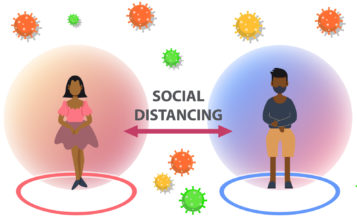The official phrase is “social distancing,” but it is helpful to think of “social distancing” as “physical distancing” instead. 
What is Social Distancing?
Social distancing is a term applied to specific actions that are taken by Public Health officials to stop or slow down the spread of a highly contagious disease since a pandemic cannot be stopped once it has started. Because coronavirus is spread mainly through respiratory droplets (especially when people cough or sneeze), maintaining a bit of distance will help to decrease the spread of the virus.
The CDC recommends maintaining a distance of about 6 feet from others when possible. By minimizing the amount of close contact we have with others, we reduce our chances of catching the virus and spreading it to our loved ones and within our community. It’s also important to practice other preventative measures such as washing hands, avoiding touching your face, coughing into your elbow and staying home if you feel sick.
Why is social distancing important?
Social distancing is important for all of us, but those of us who are at higher risk of serious complications caused by COVID-19 should be especially mindful about social distancing.
According to the National Center for Immunization and Respiratory Diseases (NCIRD), Division of Viral Diseases people who are at high risk of complications include:
- People aged 65 years and older
- People who live in a nursing home or long-term care facility
- Other high-risk conditions could include:
- People with chronic lung disease or moderate to severe asthma
- People who have heart disease with complications
- People who are immunocompromised including cancer treatment
- People of any age with severe obesity (body mass index [(BM]I)‚â•40) or certain underlying medical conditions, particularly if not well controlled, such as those with diabetes, renal failure, or liver disease might also be at risk
- People who are pregnant should be monitored since they are known to be at risk with severe viral illness, however, to date data on COVID-19 has not shown increased risk
Ways to Stay Social
Reaching out to people you trust is one of the best ways to reduce anxiety, depression, loneliness, and boredom during social distancing, quarantine, and isolation.
You can:
- Use the telephone, email, text messaging, and social media to connect with friends, family, and others.
- Talk “face to face” with friends and loved ones using Skype or FaceTime.
- Taking a walk or a hike or riding bikes are great ways to get out and get active without having physical contact.
What are other ways to limit the spread of disease?
Other public health measures could include isolation and quarantine. According to the CDC’s latest guidance:
Isolation refers to the separation of a person or people known or reasonably believed to be infected or contagious from those who are not infected in order to prevent spread of the disease. Isolation may be voluntary, or compelled by governmental or public health authorities.
Quarantine in general means the separation of a person or people reasonably believed to have been exposed to a communicable disease but not yet symptomatic from others who have not been so exposed in order to prevent the possible spread of the disease. With COVID-19, the CDC has recommended a 14-day period to monitor for symptoms.
To slow the spread of COVID-19, the White House and the CDC has issued guidelines for Americans to follow. Do your part to slow the spread of COVID-19 (coronavirus) and practice Social Distancing.
For more information visit www.coronavirus.gov or www.cdc.gov.
